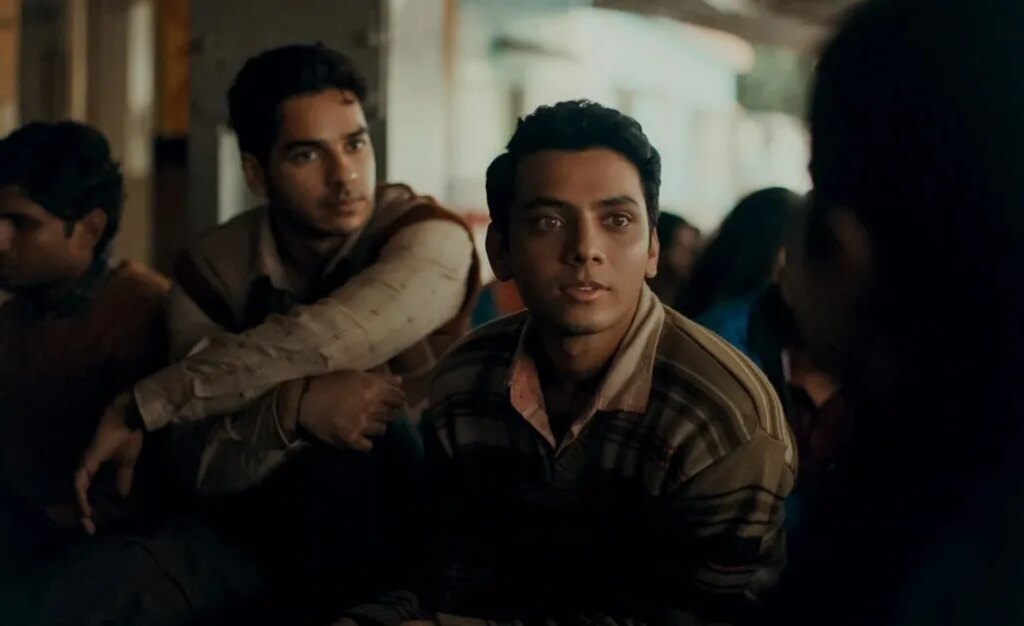Warning: This post contains spoilers for Homebound.
Homebound, directed by Neeraj Ghaywan and out now on Netflix, is inspired by a 2020 New York Times essay by journalist Basharat Peer that captured a striking moment during India’s COVID lockdown. The article chronicled the lives of two childhood friends, Mohammad Saiyub and Amrit Kumar, whose journey home to the village of Devari became a viral story after a photograph captured one friend cradling the other, feverish and dehydrated, on the side of a highway.
[time-brightcove not-tgx=”true”]
Starring Ishaan Khatter, Vishal Jethwa, and Janhvi Kapoor, Homebound follows Shoaib (Ishaan Khatter) and Chandan (Vishal Jethwa) as they attempt to secure a police job that promises dignity, only to be caught in the brutal socio-political reality of India during the 2020 lockdown. Shoaib, a Muslim, is inspired by Mohammad Saiyub, while Chandan, a Dalit, is based on Amrit Kumar. In a country with rising Islamophobia and where caste discrimination is officially outlawed but the stigma persists, their friendship highlights the intersection of social divisions, loyalty, and resilience.
Backed by Bollywood heavyweight Karan Johar’s Dharma Productions and executive produced by Martin Scorsese, Homebound premiered at the Cannes Film Festival and later screened at the Toronto International Film Festival, before its theatrical release on September 26, 2025. The film is also India’s official entry for the 98th Academy Awards for Best International Feature Film.
Here’s what to know about the true story that inspired Homebound, coming to Netflix on Nov. 21.
The childhood friends
Mohammad Saiyub, a 22-year-old Muslim, and Amrit Kumar, a 24-year-old Dalit, grew up together in the small village of Devari in Basti, Uttar Pradesh, navigating deeply entrenched social and religious divisions. Despite these social barriers, the two formed a close friendship from childhood.
As young adults, they moved to Surat on India’s west coast to work in local factories, sharing a rented room while working in separate jobs. Their goal was to save money to support their families back home in Devari. But when COVID-19 hit and the government imposed a nationwide lockdown in 2020, factories shut down and jobs disappeared, leaving the friends with dwindling savings and no clear way to return home.
A dangerous journey home
Trying to get back home, Saiyub and Kumar initially tried to secure seats on government-run special trains for migrant workers, but after weeks without success, they turned to a truck transporting workers north to Uttar Pradesh. They agreed to pay the driver 4,000 Indian rupees each—approximately $53 at the time and about $45 today.
The pair walked roughly 15 miles alongside about 60 other workers to reach a secluded spot on the highway where the truck was waiting. Once aboard, they endured the long, uncomfortable journey in a cramped balcony-like space above the driver’s cabin.
By the following day, Kumar had developed a high fever and began shivering. Fellow passengers, fearing a COVID-19 infection, insisted that he leave the truck. Saiyub refused to abandon his friend, helping him down into the midday heat. They waited in a small clearing by the highway, where a local politician arrived to provide food and water. Saiyub stayed at Kumar’s side, attempting to cool him and keep him conscious as his condition worsened.
An ambulance eventually transported them to a local hospital in Kolaras. At that point, they were still more than 310 miles away from their village in Devari. Doctors initially suspected heatstroke and low blood sugar and began oral rehydration therapy to stabilize him. As Kumar’s condition deteriorated, he was transferred to a better-equipped hospital in Shivpuri, where he was admitted to the intensive care unit with severe dehydration. Saiyub was placed in a quarantine ward while awaiting COVID-19 test results, staying anxiously aware of his friend’s critical condition and concerned about the impact on Kumar’s family.
The photograph that went viral
On May 15, 2020, a photograph—taken before the ambulance arrived—captured a heartbreaking moment along a highway in central India: Mohammad Saiyub cradling his friend Amrit Kumar in his lap, feverish, dehydrated, and barely conscious. Beside them lay a half-empty water bottle and a red bag, while the sun beat down on the clearing.
The image quickly spread across Indian social media, becoming a powerful symbol of unwavering friendship, human vulnerability, and the hidden toll of the COVID lockdown on migrant workers. It immortalized not just a tragic moment, but the broader struggle of countless laborers facing grueling journeys home amid the pandemic.
The tragic death of Amrit Kumar
On May 16, 2020, a nurse confirmed Saiyub’s worst fear: Amrit had died from severe dehydration. Both friends had tested negative for COVID-19, demonstrating that the fatal circumstances were due to the harsh conditions of the journey rather than the virus. Saiyub then faced the challenge of bringing Amrit’s body home amid strict lockdown rules. Government officials initially blocked Amrit’s father from traveling, and Saiyub had to navigate bureaucracy, praying for a negative COVID result so he could safely return his friend to Devari.
After receiving confirmation that both tests were negative, Saiyub transported Amrit’s body to the village. He was buried in the local Dalit graveyard under a simple mound of earth.
Amrit’s death left a lasting impact on his family, who had relied on his income and support. His modest contributions, including a small brick home, underscored his role in sustaining their lives. Saiyub returned to Devari with his parents, facing economic uncertainty while grieving his lifelong friend. Peer’s essay framed their story within the wider struggles of India’s migrant workers, highlighting caste, class, and social vulnerabilities revealed during the pandemic.
How Homebound ends
Homebound stays true to the emotional heart of the real story while sharpening its final moments to highlight friendship, inequality, and loss. Before the journey home, the film follows Shoaib and Chandan as they await the results of a police recruitment exam that represents their shared hope for upward mobility. When the list is released, only Chandan is selected. His family celebrates, believing the job will finally allow them to build a brick-and-cement house. Shoaib, meanwhile, has aged out and can no longer reapply. Chandan passes the physical test with distinction—but soon learns that all police appointments have been suspended indefinitely due to the pandemic, leaving his future on hold.
The emotional climax unfolds on the journey back to their village. In an overcrowded truck of migrant workers, Chandan develops a high fever and delirium. Fearing he has COVID-19, the other passengers demand that he be removed. The driver forces both Chandan and Shoaib to step out in the middle of the highway. As Chandan drifts between lucidity and confusion, Shoaib tries to comfort him, but his condition deteriorates rapidly. Chandan dies in his friend’s arms.
Shoaib returns to Devari with Chandan’s body and gives his mother a pair of sandals—fulfilling her son’s last request. Later, the family completes the brick house as a quiet tribute. In a cruel twist of timing, Chandan’s official police appointment letter arrives only after his death.
In the final scene, Shoaib revisits the riverside spot where the two used to meet. Inspired by his friend’s struggle, he decides to resume his studies. A white dove lands beside him, symbolizing hope—and the fragile possibility of rebuilding after profound loss.
The post The Heartbreaking True Story Behind Homebound appeared first on TIME.




